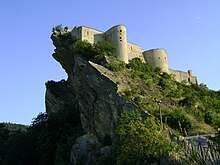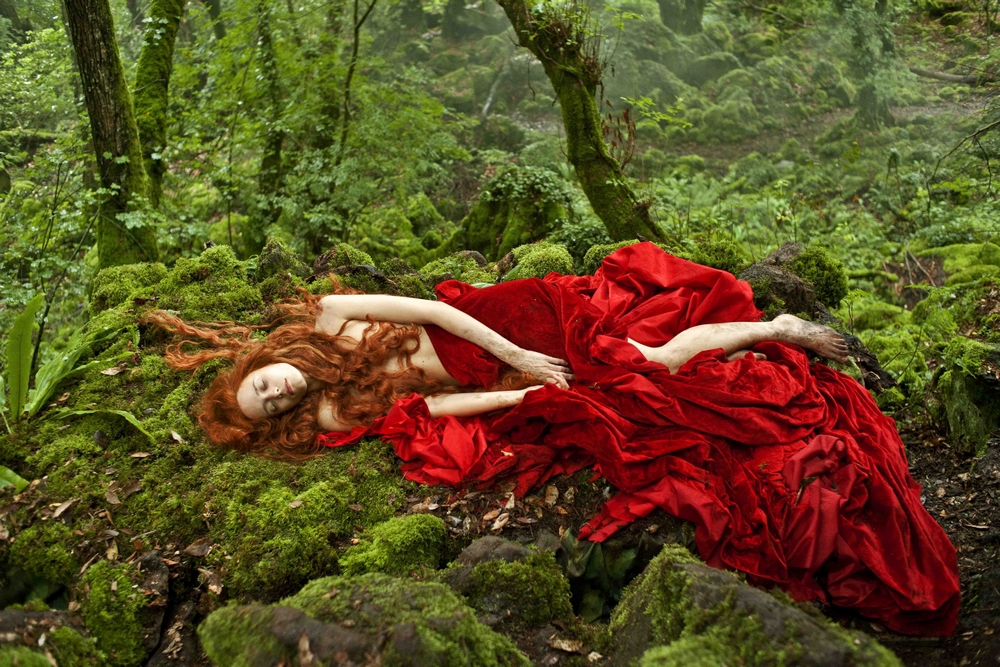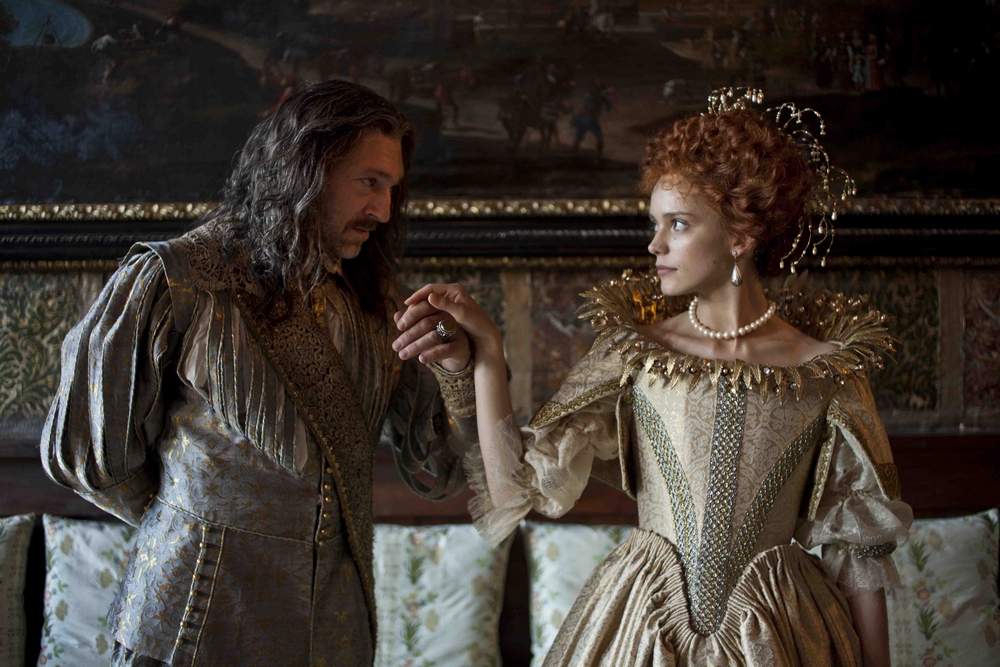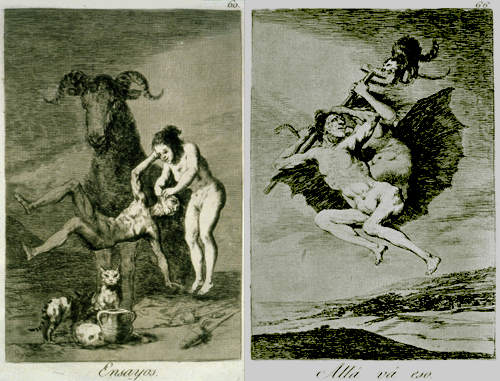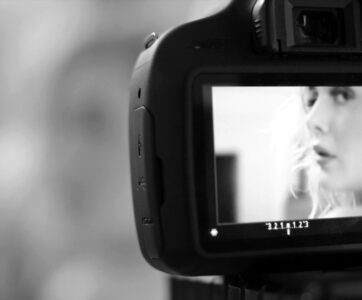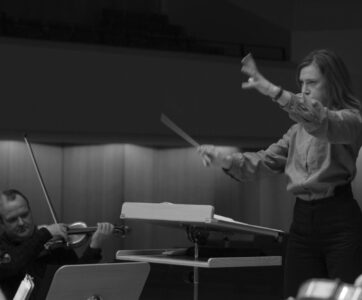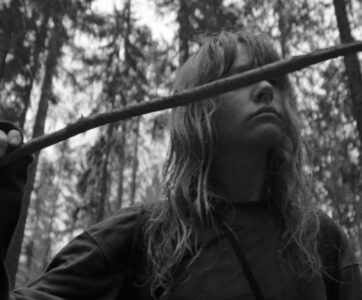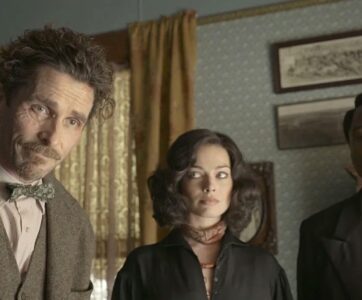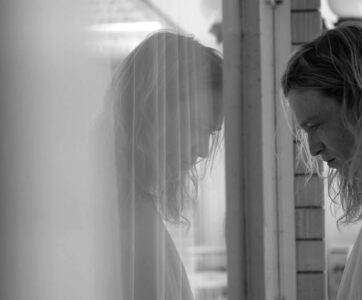© ARCHIMEDE
О съеденном сердце и отсутствии магии
15 мая 2015
Вероника Бруни
В 2008 году Маттео Гарроне получил Гран-при Каннского кинофестиваля и пять наград Европейской киноакадемии за фильм «Гоморра». В фильме была произведена процедура дегероизации скотства – необычная для зрелищного искусства, по самой своей природе наводящего лоск на ординарный разбой и бойню. Конечно, к тому времени само понимание кино как зрелища в очередной раз утратило популярность, и даже Голливуд слегка скорректировал свою продукцию. Зрелище повсюду вытесняла медитация, пришедшая с тайского востока, но еще сильнее подтачивала основы качественно рассказанной истории так называемая документальная объективность.
«Гоморра», на первый взгляд, как раз и была беспристрастным наблюдением за социальным организмом, пораженным мафией – каморрой, показанной как токсичная биомасса. Гарроне показал повседневную эрозию на клеточном уровне общества, и даже подверг свой собственный фильм ее разрыхляющему воздействию, будто пропитав его той же заразой. В картине было минимум связного сюжета, камера наблюдала круговорот доз, грязи, болезни. Маттео Гарроне лишил насилие и порок не только товарного вида, но и драматизма, выставил в их истинном ублюдочном свете – как грязь под ногтями, так что любоваться там было решительно нечем. Смотреть «Гоморру» было неудобно и муторно, что являлось первой доблестью этого фильма, жертвующего собственной привлекательностью, чтобы затея в целом имела смысл. Эстетическое саморазрушение фильма было самым радикальным художественным жестом в новейшей истории кино, и уж точно – единственным граждански реалистичным поступком. Режиссеру было не за что спрятаться, нечем было камуфлировать собственую пустоту или недостаточность ремесла, ни единого декоративного элемента, но по силе это напоминало проклятых французских поэтов начала века, у которых мертвые ослы разлагались тоже отнюдь не бесцельно. Гарроне был как на ладони, и он дошел до сути явления, о котором намеревался сказать – о масштабах, в каких люди шли и идут на убой. И до, и после «Гоморры» он снимал более или менее удачные фильмы, броские, как «Таксидермист» или вязкие, как «Реалити-шоу» о телевидении эпохи Берлускони. Но в «Сказке сказок», которую мы вчера посмотрели, он связан с «Гоморрой» на каком-то дословесном, клеточном уровне.

© ARCHIMEDE
Со сказкой, грязной и грубой по своей природе, мы почти не знакомы, потому что в определенный период ее средневековая непристойность и дикость уступила место романтической привлекательности. Литературная сказка навела глянец на жуткие сюжеты, которые сопровождали людей от их рождения до смерти, нацепила дидактический чепец. Сказка попала в цивилизацию. Маттео Гарроне возвращает ее на место (хотя и переводит с неаполитанского диалекта на английский язык) – до знаменитых собирателей и обработчиков, до братьев Гримм, до Шарля Перро, тем более до Андерсена, по-своему остро прочувствовавшего всю болезненность и связанность со смертью «сказок и историй». Но с каким почтением Гаррроне это проделывает. Он обращается к неаполитанским сказкам, которые собрал солдат и поэт 16 века Джамбаттиста Базиле. Изданные посмертно под именем аббата Джан Алезио, они дали следующим поколениям сюжеты «Золушки», «Кота в сапогах», «Гензель и Гретель». В «Пентамероне» Базиле – по аналогии с «Декамероном» Бокаччо – 50 сказок рассказываются на протяжении пяти дней, отсюда и название: «пента» и есть «пять». Гарроне не воспользовался этой структурой и опирается на сюжеты, менее известные в качестве сказок, но довольно распространенные в жизни, где быть человеком и чудовищем – не означает быть разными существами, как это происходит с королевой-несмеяной, пожирающей сердце чудовища, чтобы родить сына. Она расплатится за свои сбывшиеся желания жизнью, приняв обличье монстра, при этом не переставая им быть ни на минуту.

Уорвик Гобл. Иллюстрация к викторианскому изданию «Пентамерона». 1893
В «Сказке сказок» одновременно есть, чем очаровываться, и в то же время – нечем, потому что флер романтики еще не изобретен. Это очень декоративный фильм, к тому же с участием звезд – Сельма Хайек, Венсан Кассель, Джон Кристофер Рейли и Стейси Мартин, сыгравшая юную нимфоманку у Ларса фон Триера. В нем есть кадры ослепительной красоты и впечатляющей меланхолии, например, когда два подростка-альбиноса, дети водяного дракона, идут по дну, наслаждаясь разделенным друг с другом миром, общностью их происхождения, детской дружбой, родной средой. Такие волнующие моменты в фильме редки, они подобны единственному здоровому пальцу, который просовывает в замочную скважину обезображенная красильным трудом старуха, чтобы показать его влюбленному королю. И это соответствует намерению режиссера, потому что поэзия и великодушие во все времена умещаются на кончике пальца посреди мясного брутального хаоса, с которым цивилизация не умеет справляться.

Маттео Гарроне на съемках «Сказки сказок». © ARCHIMEDE
Фильм не имеет отношения к магии сказки. Хотя ведьма превращает старуху в красавицу, а мать жертвует собой ради сына, становясь чудовищем, которое он убьет, в нем нет волшебства ради очарования и соблазна. Гарроне фиксирует все ту же историю насилия, которая пишется от начала времен. В ней огры, короли и принцессы – все те же социальные типажи, только в причудливых нарядах. Гарроне живописно скрещивает реалистичный взгляд с костюмным кино, и не он первый. И хотя на память приходят «Братья Гримм» Терри Гиллиама, это поверхностная аналогия. В действительности это проделал Отар Иоселиани в «Разбойниках, главе седьмой», когда показал как воспроизводится одна и та же преступная порода, какой слой времени ни копни. Всем своим строем «Сказка сказок» пртивоположна тем магическим пассам, которые весело и экспрессивно творит Гильермо дель Торо, но потому и способна произвести впечатление на этого волшебника из жюри.
| Tale of Tales | |
|---|---|

Theatrical release poster |
|
| Italian | Il racconto dei racconti |
| Directed by | Matteo Garrone |
| Written by |
|
| Based on | Pentamerone by Giambattista Basile |
| Produced by |
|
| Starring |
|
| Cinematography | Peter Suschitzky |
| Edited by | Marco Spoletini |
| Music by | Alexandre Desplat |
|
Production |
|
| Distributed by |
|
|
Release dates |
|
|
Running time |
134 minutes |
| Countries |
|
| Language | English |
| Budget | $14.5 million[2] |
| Box office | $5.5 million[1][3] |
Tale of Tales is a 2015 European fantasy horror film co-written, directed and co-produced by Matteo Garrone and starring Salma Hayek, Vincent Cassel, Toby Jones, and John C. Reilly.
An Italian-led production with co-producers in France and the United Kingdom, Tale of Tales is Garrone’s only English-language film. It competed for the Palme d’Or at the 2015 Cannes Film Festival.[4][5]
It is a screen adaptation based on collections of tales by Italian poet and courtier Giambattista Basile: Pentamerone or Lo cunto de li cunti (Tale of Tales, or Entertainment for Little Ones), which contains the earliest versions of famous fables like Rapunzel, Sleeping Beauty and Cinderella. The three tales are La Cerva Fatata (The Enchanted Doe), La Pulce (The Flea), La Vecchia Scorticata (The Flayed Old Lady), which have been freely adapted with elements of other tales by Giambattista Basile as well as a touch of artistic license.[6]
Plot[edit]
The Enchanted Doe[edit]
In the Kingdom of Longtrellis, the King and Queen cannot conceive a child. A necromancer suggests that if the Queen eats a sea dragon’s heart cooked by a virgin, she will be with child but this will cost a life. The King slays the sea dragon but dies from his wounds. The Queen eats the heart and the next day bears a son, Elias, with hair as white as the dragon. The cook also gives birth to a boy, Jonah. The boys are identical and inseparable friends. This so vexes the Queen that she attempts to murder Jonah, though he manages to escape. Jonah leaves the kingdom, plunging a knife into a tree root and telling Elias that as long as the root spouts clear water, he is alive and well. One day the water is clouded with blood. Elias leaves to find Jonah. The Queen has her subjects search for Elias to no avail. The necromancer blames the Queen and says the youths are truly inseparable, and that her violent desire can be achieved only through violence. Elias finds Jonah wounded in a cave. They are threatened by a monster, which wounds Jonah but hesitates to attack Elias, who kills the monster and returns Jonah to his wife. In the cave, the monster’s corpse dissolves into that of the Queen.
The Flayed Old Lady[edit]
The lustful King of Strongcliff is intrigued by the sound of a woman’s heavenly singing. He courts her outside her home, unaware that she is one of two elderly sisters, Imma and Dora. Dora agrees to spend the night with him as long as it is in complete darkness. He is horrified when he sees her appearance the next morning, and has his guards throw her out of the window. She survives, entangled in the branches of a tree. A witch rescues her and nurses her from her breast. Dora awakens as a young, beautiful maiden. The King comes upon her while hunting and decides to make her his Queen. Dora invites Imma to the wedding and promises to take care of her, but says she cannot stay in the castle. Imma refuses to leave, asking for the secret to her sister’s youth and beauty. In annoyance, Dora says she got herself flayed. Finally thrown out after violating the royal couple’s privacy in their bedroom, Imma finds someone willing to flay her, leaving her bloody and disfigured.
The Flea[edit]
The King of Highhills becomes fascinated by a flea, which he hides in his room as a pet. It grows gigantic under his care. When it dies, the King decides to skin it. His daughter Violet tells him she wants to be married, so he offers her as a bride to whoever can guess from what beast the skin was taken, believing no-one can do so. However, an ogre correctly identifies the hide by smell. Violet is horrified but her father says he cannot go back on his word. Violet goes through with the marriage but says her father never loved her. The ogre takes Violet to his cave, where she is raped and kept prisoner. A family of acrobats helps her to escape, but the ogre gives chase and kills the entire family. He is mollified by Violet, who then slits his throat. Violet returns to the castle, where the King has grown ill and reveals she has the head of the ogre, the husband he «chose» for her. The King falls to his knees crying and the courtiers follow suit. Violet, too, begins to cry.
Elias, Dora and the King of Strongcliff are among the guests for Violet’s coronation as Queen. There, Elias nods to her and the King of Strongcliff. As Violet’s father walks her to the throne the crowd looks skyward, where an entertainer is walking a tightrope of fire. We see Dora’s beauty begin to fade and, unnoticed, she flees the castle.
Themes[edit]
In an interview with Variety, director Matteo Garrone emphasized that the three tales have contemporary themes: «plastic surgery; the frenzied desire to have a child; the conflict between generations; the painful passage from adolescence to adulthood.»[7] He has also said that although the three stories have distinct themes, they are all connected to the idea of desire that can lead to obsession. Although screenplays were written for other tales in the Basile collection, those filmed told the story of «a woman in three different stages of her life»: youth, motherhood and advancing age.[8]
Cast[edit]
- Salma Hayek as Queen of Longtrellis
- Vincent Cassel as King of Strongcliff
- Toby Jones as King of Highhills
- John C. Reilly as King of Longtrellis
- Shirley Henderson as Imma
- Hayley Carmichael as Dora
- Stacy Martin as young Dora
- Bebe Cave as Violet, Princess of Highhills
- Christian Lees as Elias, Prince of Longtrellis.
- Jonah Lees as Jonah
- Laura Pizzirani as the virgin and Jonah’s Mother
- Franco Pistoni as Necromancer
- Jessie Cave as Fenizia
- Michael Martini as the 1st Circus Boy
- Alessandro Campagna as the 2nd Circus Boy
- Lorenzo Bernardi as Contortionist
- Giselda Volodi as Lady-in-Waiting #1
- Giuseppina Cervizzi as Lady-in-Waiting #2
- Luisa Ragusa as Lady-in-Waiting #3
- Kathryn Hunter as Witch
- Guillaume Delaunay as Ogre
- Davide Campagna as Circus Performer
- Massimo Ceccherini as a Circus Artist Father
- Alba Rohrwacher as a Circus Artist Mother
Production[edit]
Development[edit]
According to Matteo Garrone, he was drawn to Giambattista Basile’s stories for their mixture of the real and the unreal, and because he found the themes in many of them to still be highly relevant. Garrone had previously been best known for employing a naturalist style in films such as Gomorrah, but argued that all his previous films also have a fairytale aspect to their narratives.[2] An important source of inspiration was Francisco Goya’s Los caprichos collection of etchings. For Garrone, they encapsulated the mood of Basile’s tales.[9]
Tale of Tales had a budget corresponding to USD$14.5 million.[2] It was produced through Garrone’s company Archimede Film, with co-production support from France’s Le Pact and Britain’s Recorded Picture Company. It received financing from Rai Cinema and additional support from MiBACT and Eurimages.[10]
Filming[edit]
Principal photography commenced on 15 May 2014 and lasted four months.[10] The film was shot entirely on location in various parts of Italy, including Naples (Royal Palace, Palace of Capodimonte and its gardens); Apulia’s Castel del Monte (octagonal castle appears in the poster near Vincent Cassel), Gioia del Colle (in particular the throne room), Laterza, Mottola, Statte; Sicily’s Donnafugata Castle (gothic castle, stone labyrinth and gardens) and Gole dell’Alcantara in Alcantara (mainly scenes of sea dragon); Abruzzo’s Castello di Roccascalegna (appears in the poster with Castel del Monte); Tuscany’s Moorish castle of Sammezzano, the towns of Sorano and Sovana (tuff caves); and Lazio (Bosco del Sasseto in Viterbo).[11][12][13][14][15][16][17] «The movie is an epic tribute to the history of fairytales with great care to the style of their portrayal. The very locations reflect the director’s intention to create an artificial truth, a realistic craftsmanship. All locations had to be real but look as if the settings had been recreated in a studio set.»[18][2]
Release[edit]
Critical reception[edit]
On the review aggregator website Rotten Tomatoes, the film holds a 83% approval rating based on reviews from 105 critics, with an average rating of 7 out of 10. The website’s critical consensus reads, «Visually splendid and narratively satisfying, Tale of Tales packs an off-kilter wallop for mature viewers in search of something different.»[19] On Metacritic, the film has received a weighted average score of 72 out of 100 based on 24 critics, indicating «generally favorable reviews».[20]
|
This section needs expansion. You can help by adding to it. (November 2018) |
References[edit]
- ^ a b «Tale of Tales (2016)». Box Office Mojo. Retrieved 19 June 2017.
- ^ a b c d Vivarelli, Nick (15 May 2014). «Cannes: Italo Auteur Matteo Garrone Talks About His ‘Tale of Tales’ (Exclusive)». Variety. Retrieved 13 March 2015.
- ^ «Tale of Tales Foreign Gross (2016)». Box Office Mojo. Retrieved 19 June 2017.
- ^ «2015 Official Selection». Cannes. Retrieved 16 April 2015.
- ^ «Screenings Guide». Festival de Cannes. 6 May 2015. Retrieved 8 May 2015.
- ^ «Tale of Tales Movie Review». shockya.com.
- ^ «Cannes: How ‘Game of Thrones’ Influenced ‘Tale of Tales’«. Retrieved 14 May 2015.
- ^ Garrone, Matteo (Director) (2016). «Extras». Tale of Tales (DVD). United Kingdom: Fusion Media Sales (distributor).
We wrote a screenplay for some other stories too, but in the end we chose to tell the story of a woman in three different stages of her life. We show a female perspective at three different stages. There are three distinct themes but they are all connected to the idea of desire that can lead to obsession.
- ^ Garrone, Matteo (Director) (2016). «Extras». Tale of Tales (DVD). United Kingdom: Fusion Media Sales (distributor).
There are so many sources of inspirations… The first that comes to mind, and possibly the most important of all, were Goya’s Los Caprichos. They were absolutely crucial although they date from around two centuries after Basile’s. These etchings encapsulate the mood that I saw in Basile’s tales, the coexistence of tragedy and comedy, the representation of deformed grotesque figures… and the relationship with human beings, with a body that can transform and take on animal traits… Goya’s etchings were a crucial point of reference for us.
- ^ a b Scarpa, Vittoria (16 May 2014). «Shooting kicks off for Tale of Tales by Matteo Garrone». Cineuropa. Retrieved 13 March 2015.
- ^ «The Tales of Tales 4 things of Garrone’s magical movie». SWIDE.
- ^ «The Tale of Tales Official Trailer #1 2015, Cast, Released Date {2015} in France, Italy, UK, India». whatstheinfo. Archived from the original on 29 October 2016.
- ^ «Il Racconto dei Racconti: scelte le location del prossimo film di Matteo Garrone con Vincent Cassel e Salma Hayek protagonisti». bestmovie.it.
- ^ «Garrone gira a Ragusa con un cast internazionale». La Repubblica.
- ^ «Sul set con Garrone: «Il mio kolossal fantasy, a Castel del Monte con Vincent Cassel»«. La Repubblica.
- ^ «Il Racconto dei Racconti 2015». movieplayer.it.
- ^ «Shooting kicks off for Tale of Tales by Matteo Garrone». cineuropa.org.
- ^ Gabardi, Chiara. «Tale of Tales Movie Review». Shock ya!. Retrieved 20 November 2018.
- ^ «Tale of Tales (2016)». Rotten Tomatoes. Retrieved 22 April 2017.
- ^ «Tale of Tales Reviews». Metacritic. Retrieved 22 April 2017.
External links[edit]
- Tale of Tales at IMDb
- Tale of Tales at Rotten Tomatoes
- Tale of Tales at Metacritic
| Tale of Tales | |
|---|---|

Theatrical release poster |
|
| Italian | Il racconto dei racconti |
| Directed by | Matteo Garrone |
| Written by |
|
| Based on | Pentamerone by Giambattista Basile |
| Produced by |
|
| Starring |
|
| Cinematography | Peter Suschitzky |
| Edited by | Marco Spoletini |
| Music by | Alexandre Desplat |
|
Production |
|
| Distributed by |
|
|
Release dates |
|
|
Running time |
134 minutes |
| Countries |
|
| Language | English |
| Budget | $14.5 million[2] |
| Box office | $5.5 million[1][3] |
Tale of Tales is a 2015 European fantasy horror film co-written, directed and co-produced by Matteo Garrone and starring Salma Hayek, Vincent Cassel, Toby Jones, and John C. Reilly.
An Italian-led production with co-producers in France and the United Kingdom, Tale of Tales is Garrone’s only English-language film. It competed for the Palme d’Or at the 2015 Cannes Film Festival.[4][5]
It is a screen adaptation based on collections of tales by Italian poet and courtier Giambattista Basile: Pentamerone or Lo cunto de li cunti (Tale of Tales, or Entertainment for Little Ones), which contains the earliest versions of famous fables like Rapunzel, Sleeping Beauty and Cinderella. The three tales are La Cerva Fatata (The Enchanted Doe), La Pulce (The Flea), La Vecchia Scorticata (The Flayed Old Lady), which have been freely adapted with elements of other tales by Giambattista Basile as well as a touch of artistic license.[6]
Plot[edit]
The Enchanted Doe[edit]
In the Kingdom of Longtrellis, the King and Queen cannot conceive a child. A necromancer suggests that if the Queen eats a sea dragon’s heart cooked by a virgin, she will be with child but this will cost a life. The King slays the sea dragon but dies from his wounds. The Queen eats the heart and the next day bears a son, Elias, with hair as white as the dragon. The cook also gives birth to a boy, Jonah. The boys are identical and inseparable friends. This so vexes the Queen that she attempts to murder Jonah, though he manages to escape. Jonah leaves the kingdom, plunging a knife into a tree root and telling Elias that as long as the root spouts clear water, he is alive and well. One day the water is clouded with blood. Elias leaves to find Jonah. The Queen has her subjects search for Elias to no avail. The necromancer blames the Queen and says the youths are truly inseparable, and that her violent desire can be achieved only through violence. Elias finds Jonah wounded in a cave. They are threatened by a monster, which wounds Jonah but hesitates to attack Elias, who kills the monster and returns Jonah to his wife. In the cave, the monster’s corpse dissolves into that of the Queen.
The Flayed Old Lady[edit]
The lustful King of Strongcliff is intrigued by the sound of a woman’s heavenly singing. He courts her outside her home, unaware that she is one of two elderly sisters, Imma and Dora. Dora agrees to spend the night with him as long as it is in complete darkness. He is horrified when he sees her appearance the next morning, and has his guards throw her out of the window. She survives, entangled in the branches of a tree. A witch rescues her and nurses her from her breast. Dora awakens as a young, beautiful maiden. The King comes upon her while hunting and decides to make her his Queen. Dora invites Imma to the wedding and promises to take care of her, but says she cannot stay in the castle. Imma refuses to leave, asking for the secret to her sister’s youth and beauty. In annoyance, Dora says she got herself flayed. Finally thrown out after violating the royal couple’s privacy in their bedroom, Imma finds someone willing to flay her, leaving her bloody and disfigured.
The Flea[edit]
The King of Highhills becomes fascinated by a flea, which he hides in his room as a pet. It grows gigantic under his care. When it dies, the King decides to skin it. His daughter Violet tells him she wants to be married, so he offers her as a bride to whoever can guess from what beast the skin was taken, believing no-one can do so. However, an ogre correctly identifies the hide by smell. Violet is horrified but her father says he cannot go back on his word. Violet goes through with the marriage but says her father never loved her. The ogre takes Violet to his cave, where she is raped and kept prisoner. A family of acrobats helps her to escape, but the ogre gives chase and kills the entire family. He is mollified by Violet, who then slits his throat. Violet returns to the castle, where the King has grown ill and reveals she has the head of the ogre, the husband he «chose» for her. The King falls to his knees crying and the courtiers follow suit. Violet, too, begins to cry.
Elias, Dora and the King of Strongcliff are among the guests for Violet’s coronation as Queen. There, Elias nods to her and the King of Strongcliff. As Violet’s father walks her to the throne the crowd looks skyward, where an entertainer is walking a tightrope of fire. We see Dora’s beauty begin to fade and, unnoticed, she flees the castle.
Themes[edit]
In an interview with Variety, director Matteo Garrone emphasized that the three tales have contemporary themes: «plastic surgery; the frenzied desire to have a child; the conflict between generations; the painful passage from adolescence to adulthood.»[7] He has also said that although the three stories have distinct themes, they are all connected to the idea of desire that can lead to obsession. Although screenplays were written for other tales in the Basile collection, those filmed told the story of «a woman in three different stages of her life»: youth, motherhood and advancing age.[8]
Cast[edit]
- Salma Hayek as Queen of Longtrellis
- Vincent Cassel as King of Strongcliff
- Toby Jones as King of Highhills
- John C. Reilly as King of Longtrellis
- Shirley Henderson as Imma
- Hayley Carmichael as Dora
- Stacy Martin as young Dora
- Bebe Cave as Violet, Princess of Highhills
- Christian Lees as Elias, Prince of Longtrellis.
- Jonah Lees as Jonah
- Laura Pizzirani as the virgin and Jonah’s Mother
- Franco Pistoni as Necromancer
- Jessie Cave as Fenizia
- Michael Martini as the 1st Circus Boy
- Alessandro Campagna as the 2nd Circus Boy
- Lorenzo Bernardi as Contortionist
- Giselda Volodi as Lady-in-Waiting #1
- Giuseppina Cervizzi as Lady-in-Waiting #2
- Luisa Ragusa as Lady-in-Waiting #3
- Kathryn Hunter as Witch
- Guillaume Delaunay as Ogre
- Davide Campagna as Circus Performer
- Massimo Ceccherini as a Circus Artist Father
- Alba Rohrwacher as a Circus Artist Mother
Production[edit]
Development[edit]
According to Matteo Garrone, he was drawn to Giambattista Basile’s stories for their mixture of the real and the unreal, and because he found the themes in many of them to still be highly relevant. Garrone had previously been best known for employing a naturalist style in films such as Gomorrah, but argued that all his previous films also have a fairytale aspect to their narratives.[2] An important source of inspiration was Francisco Goya’s Los caprichos collection of etchings. For Garrone, they encapsulated the mood of Basile’s tales.[9]
Tale of Tales had a budget corresponding to USD$14.5 million.[2] It was produced through Garrone’s company Archimede Film, with co-production support from France’s Le Pact and Britain’s Recorded Picture Company. It received financing from Rai Cinema and additional support from MiBACT and Eurimages.[10]
Filming[edit]
Principal photography commenced on 15 May 2014 and lasted four months.[10] The film was shot entirely on location in various parts of Italy, including Naples (Royal Palace, Palace of Capodimonte and its gardens); Apulia’s Castel del Monte (octagonal castle appears in the poster near Vincent Cassel), Gioia del Colle (in particular the throne room), Laterza, Mottola, Statte; Sicily’s Donnafugata Castle (gothic castle, stone labyrinth and gardens) and Gole dell’Alcantara in Alcantara (mainly scenes of sea dragon); Abruzzo’s Castello di Roccascalegna (appears in the poster with Castel del Monte); Tuscany’s Moorish castle of Sammezzano, the towns of Sorano and Sovana (tuff caves); and Lazio (Bosco del Sasseto in Viterbo).[11][12][13][14][15][16][17] «The movie is an epic tribute to the history of fairytales with great care to the style of their portrayal. The very locations reflect the director’s intention to create an artificial truth, a realistic craftsmanship. All locations had to be real but look as if the settings had been recreated in a studio set.»[18][2]
Release[edit]
Critical reception[edit]
On the review aggregator website Rotten Tomatoes, the film holds a 83% approval rating based on reviews from 105 critics, with an average rating of 7 out of 10. The website’s critical consensus reads, «Visually splendid and narratively satisfying, Tale of Tales packs an off-kilter wallop for mature viewers in search of something different.»[19] On Metacritic, the film has received a weighted average score of 72 out of 100 based on 24 critics, indicating «generally favorable reviews».[20]
|
This section needs expansion. You can help by adding to it. (November 2018) |
References[edit]
- ^ a b «Tale of Tales (2016)». Box Office Mojo. Retrieved 19 June 2017.
- ^ a b c d Vivarelli, Nick (15 May 2014). «Cannes: Italo Auteur Matteo Garrone Talks About His ‘Tale of Tales’ (Exclusive)». Variety. Retrieved 13 March 2015.
- ^ «Tale of Tales Foreign Gross (2016)». Box Office Mojo. Retrieved 19 June 2017.
- ^ «2015 Official Selection». Cannes. Retrieved 16 April 2015.
- ^ «Screenings Guide». Festival de Cannes. 6 May 2015. Retrieved 8 May 2015.
- ^ «Tale of Tales Movie Review». shockya.com.
- ^ «Cannes: How ‘Game of Thrones’ Influenced ‘Tale of Tales’«. Retrieved 14 May 2015.
- ^ Garrone, Matteo (Director) (2016). «Extras». Tale of Tales (DVD). United Kingdom: Fusion Media Sales (distributor).
We wrote a screenplay for some other stories too, but in the end we chose to tell the story of a woman in three different stages of her life. We show a female perspective at three different stages. There are three distinct themes but they are all connected to the idea of desire that can lead to obsession.
- ^ Garrone, Matteo (Director) (2016). «Extras». Tale of Tales (DVD). United Kingdom: Fusion Media Sales (distributor).
There are so many sources of inspirations… The first that comes to mind, and possibly the most important of all, were Goya’s Los Caprichos. They were absolutely crucial although they date from around two centuries after Basile’s. These etchings encapsulate the mood that I saw in Basile’s tales, the coexistence of tragedy and comedy, the representation of deformed grotesque figures… and the relationship with human beings, with a body that can transform and take on animal traits… Goya’s etchings were a crucial point of reference for us.
- ^ a b Scarpa, Vittoria (16 May 2014). «Shooting kicks off for Tale of Tales by Matteo Garrone». Cineuropa. Retrieved 13 March 2015.
- ^ «The Tales of Tales 4 things of Garrone’s magical movie». SWIDE.
- ^ «The Tale of Tales Official Trailer #1 2015, Cast, Released Date {2015} in France, Italy, UK, India». whatstheinfo. Archived from the original on 29 October 2016.
- ^ «Il Racconto dei Racconti: scelte le location del prossimo film di Matteo Garrone con Vincent Cassel e Salma Hayek protagonisti». bestmovie.it.
- ^ «Garrone gira a Ragusa con un cast internazionale». La Repubblica.
- ^ «Sul set con Garrone: «Il mio kolossal fantasy, a Castel del Monte con Vincent Cassel»«. La Repubblica.
- ^ «Il Racconto dei Racconti 2015». movieplayer.it.
- ^ «Shooting kicks off for Tale of Tales by Matteo Garrone». cineuropa.org.
- ^ Gabardi, Chiara. «Tale of Tales Movie Review». Shock ya!. Retrieved 20 November 2018.
- ^ «Tale of Tales (2016)». Rotten Tomatoes. Retrieved 22 April 2017.
- ^ «Tale of Tales Reviews». Metacritic. Retrieved 22 April 2017.
External links[edit]
- Tale of Tales at IMDb
- Tale of Tales at Rotten Tomatoes
- Tale of Tales at Metacritic
На огромном сказочном континенте у каждого королевства своя мрачная история. В одном королева никак не может стать матерью, до тех пор пока таинственный знахарь не открывает королю рецепт магической пищи, способной подарить коронованному семейству наследника. Король соседнего государства в поисках единственной любимой перепробовал всех женщин в округе, но влюбился не в тело, а в песню. Осталось лишь узнать, в какую обертку помещен голос, очаровавший государя. Повелитель третьего королевства, желая выдать замуж дочь, устроил турнир, победу в котором одержало существо, один вид которого у будущей невесты вызывает ужас. Древние сказки не церемонятся ни с героями, ни со зрителями – мрачная готическая расплата постигнет всех.
Съемки картины прошли на итальянской натуре, занятые в ленте замки, сады и тронные залы расположены в Неаполе, Тоскане, Лацио и на Сицилии
С детства зная сказки братьев Гримм, Шарля Перро и Ханса Кристиана Андерсена, мы редко задумываемся о том, откуда их истории – временами веселые и поучительные, а порой мрачные и пугающие – берут свои истоки. Несомненно, многое эти авторы почерпнули из местного фольклора, но был у них и общий предшественник, человек, первым составивший сборник историй, объединивший те легенды, которые по прошествии многих лет трансформировались в привычные нам сказки. Речь идет об итальянце Джамбатисте Базиле, авторе «Сказки сказок» или «Пентамероне» – альманаха страшных, но поучительных рассказов. Именно на эту книгу опирался режиссер Маттео Гарроне, снимая собственный сказочный сборник, свою Метасказку, собравшую самые главные человеческие ценности.
Несмотря на то что финансировать создание картины взялись французская и итальянская компании, а также Европейский фонд развития кино, фильм было решено снимать на английском языке. «Страшные сказки» – англоязычный дебют Маттео Гарроне
Начать стоит с того, что за постановку взялся режиссер, который ранее был страшно далек от выдумки, иллюзий и развлечений. Среди критиков Гарроне известен своими натуралистичными драмами, препарирующими настоящее, окружающий постановщика мир, такими как «Гаморра» или «Реальность». Неожиданный выбор материала и скульптора, которому предстояло высечь произведение искусства, породил невероятный эффект – подобных сказок вы точно еще не видели. Пусть они не всегда оригинальны, во многом противоречивы и даже слегка косо собраны, но кино получилось невероятно атмосферным, по-хорошему пугающим и фантастически красивым.
Не станем углубляться в характеры героев или сюжетные перипетии, чтобы не портить удовольствие от просмотра, а лишь заглянем на последнюю страницу этого сборника сказок, туда, где кроется «сказка ложь, да в ней намек», ведь мораль гораздо важнее всего того, что к ее пониманию приводит. А мораль в фильме ужасающа, как и положено выводу из «Страшных сказок», – нет в этих трех царствах прекрасных принцев и восхитительных принцесс, исчезли благородные рыцари, а воспитанные дамы и не появлялись. Всеми в трех королевствах движет эгоизм, жажда наживы и банальная глупость. Жена, столь сильно желающая родить ребенка, что без сожаления жертвует ради этого мужем. Ловелас, польстившийся на красивую обертку и не желающий знать, что прячется у его избранницы внутри. Отец, настолько увлеченный собой, что замужество дочери за огром его нисколько не смущает. Гротескный мир Гарроне лишь добавляет красок дню сегодняшнему. Прошло 400 лет со дня написания «Пентамероне», а изменилось совсем немногое – лесных колдуний заменили спа-салоны, блоху заменил телевизор, а уж про браки по расчету, где супругов ничего не связывает, и говорить нечего.
Однако Гарроне говорит. Может быть, несколько вальяжно и витиевато, возможно, чуть затянуто и порой слишком подробно, но все это позволяет по-настоящему окунуться в прекрасный мир «Страшных сказок». Блестящий оператор Питер Сушицки проведет вас по дну моря и чаще леса, поднимет на вершины скал и опустит во влажные низовья – лента снята с таким размахом декораций, что картинка ее буквально светится великолепными замками и хижинами. К радости фанатов олдскула, не пошел режиссер и на поводу у мастеров компьютерных спецэффектов – теплые ламповые кукольные монстры придают фильму сходство с картинами Гильермо Дель Торо, а шикарные наряды запараллеливают «Сказки» с бертоновской «Алисой» или «Сонной лощиной».
Но самое главное – автору удалось остаться небанальным в своем рассказе. Конечно, если ваше знание готических сказок не ограничивается «Золушкой» и «Красной Шапочкой», то вы без труда узнаете легенды, перенесенные на большой экран. Но и этим знанием картина завораживает и захватывает на все два часа хронометража. И это очень здорово – очутиться в настоящей сказке, не в компьютерном мире «хоббитов», не в глянце диснеевских авторемейков, не в детской сахарной вате удается сейчас очень редко, и стоит ценить каждый подобный момент. А «Страшные сказки» – это очень ценный момент, яркий, жуткий и цепляющий. Все, как вы любили в своем детстве, но боялись смотреть и читать.
Страшные сказки. Реж. Маттео Гарроне. 2015
Новая картина Маттео Гарроне поставлена по мотивам сборника неаполитанских сказок, записанных в XVI веке Джамбаттистой Базиле, который, сам того не ведая, стал первым в европейской истории фольклористом, указавшим путь Шарлю Перро и братьям Гримм; сказки он сохранил в недетских версиях — недетское же кино по ним снял и Гарроне. От сорока девяти вечеров Базиле (его сказки рассказывают по одной, как в «Декамероне») остались три истории: про бездетную королеву, которая отправила мужа на смерть, съела сердце морского дракона и понесла, но сначала проверила пищу на девственнице-служанке — родилось два одинаковых мальчика, зачатие которых не потребовало отцов (привет из глубокого матриархата); про короля, который вырастил в спальне гигантскую блоху, а потом по ошибке выдал дочь за орка; про двух сестер-старух, одна из которых загадочно помолодела и стала женой любвеобильного короля.
Страшные сказки. Реж. Маттео Гарроне. 2015
Интересно, что фильм, с которым режиссер по-настоящему прославился — «Гоморра» (2008) — был экранизацией документальной книги о неаполитанской мафии, а его следующая картина, рассказывающая о столкновении простого человека с миром телевидения, называлась «Реальность» (2012). И то, и другое на первый взгляд максимально далеко от сказки, но, по словам самого режиссера, в сборнике Базиле его привлекло сочетание пластов доисторической, внеисторической архаики с очень конкретными деталями позднесредневекового быта — эпохи, которая в нашем воображении стала единственной возможной декорацией для европейской сказки («Чей это дворец, чьи эти луга?» — «Маркиза, маркиза Карабаса»).
Однако картина, в которой снялись актеры из разных стран (Сальма Хайек, Джон Си. Рейли, Ширли Хендерсен, Тоби Джонс и вечный заложник Шарля Перро — Венсан Кассель) сделана на английском: неаполитанский диалект отброшен, и главным языком этого оммажа памятнику литературы парадоксальным образом становится изображение.
И был бы уместнее набор кадров, чем текст, но в сети пока мало картинок из «Страшных сказок»; у кинофильмов, которые живут долго и счастливо, всегда есть статичный кадр-икона, который не забывается и становится мнемоническим правилом для картины, а может быть — для всего корпуса произведений режиссера. Гарроне (из всей немаленькой фильмографии которого коллективная память выбирает постер «Гоморры»: подростки в трусах и с автоматами, идущие по берегу мусорной речки) в работе над мнемоническими правилами своего кино теперь опережает многих: король в скафандре водолаза с копьем спускается в подводную пещеру; на дне озера дремлет бледный дракон; два мальчика, неотличимых друг от друга альбиноса — принц и нищий — бредут сквозь воду на место гибели дракона; старуха, снова ставшая юной, просыпается ото сна в лесу — в правом верхнем углу экрана возникает недоумевающий кабан; по горящему канату, натянутому над открытым двором замка, идет цирковой акробат… Их очень много, этих кадров, и перечисление займет не меньше времени, чем сам двухчасовой фильм.
Вверху — Страшные сказки; внизу — Гилас и нимфы (Джон Уилльям Уотерхаус)
Гарроне в качестве смутных объектов влияния называет «Капричос» Гойи, прерафаэлитов и «Казанову» Феллини: в некотором смысле «Страшные сказки» — это «Казанова» цифрового века, когда водную гладь больше не надо создавать, размахивая полиэтиленом; в обоих фильмах объекты материального мира узнаваемы, но показаны с некоторым искажением; сказка — всегда нечто иное, чем ее фабула. Искусство присваивает себе приемы глянца (так же как глянец спекулирует на искусстве), но как бы красивы (очень красивы, невероятно красивы) ни были все без исключения эпизоды «Страшных сказок», в них нет конформизма — их разглядывание вызывает подспудный дискомфорт, как будто за ними скрывается что-то большее, совсем страшное. Так мы слушаем сказки про Бабу-Ягу, можем бояться ее или смеяться над ней, но, пока не прочтем Проппа, мы не думаем о том, что она напрямую связана со смертью и о том, что «костяная нога» — это нога скелета.
Офорты из серии Капричос. Франсиско Гойя
Большая часть сюжетных линий завершена, некоторые завершены не совсем, и даже тем, кто не читал Базиле (а таких, видимо, большинство) понятно, что за пределами трех королевских замков протирается огромный сказочный мир и разворачиваются другие истории. Все вместе (изображение, драматургия и свойственная сказке замена психологизма имманентными свойствами, запретами, обрядами и ритуалами) создает ощущение реально существующей параллельной вселенной (вот она, реальность Гарроне!) — огромного океана архаики, который от рождения до смерти плещется в каждом из нас.
Читайте также
-
Это норма — «Удовольствие» Ниньи Тюберг
-
Крест на партитуре — «Тар» Тодда Филда
-
Жизнь как беспредметность — «На тебе сошелся клином белый свет» Игоря Поплаухина
-
Кстати о птичках — «Амстердам» Дэвида О. Расселла
-
Реверсивная хроника событий — «Нитрам» Джастина Курзеля
-
Все отболит — «Дурной глаз» Лоркана Финнегана



